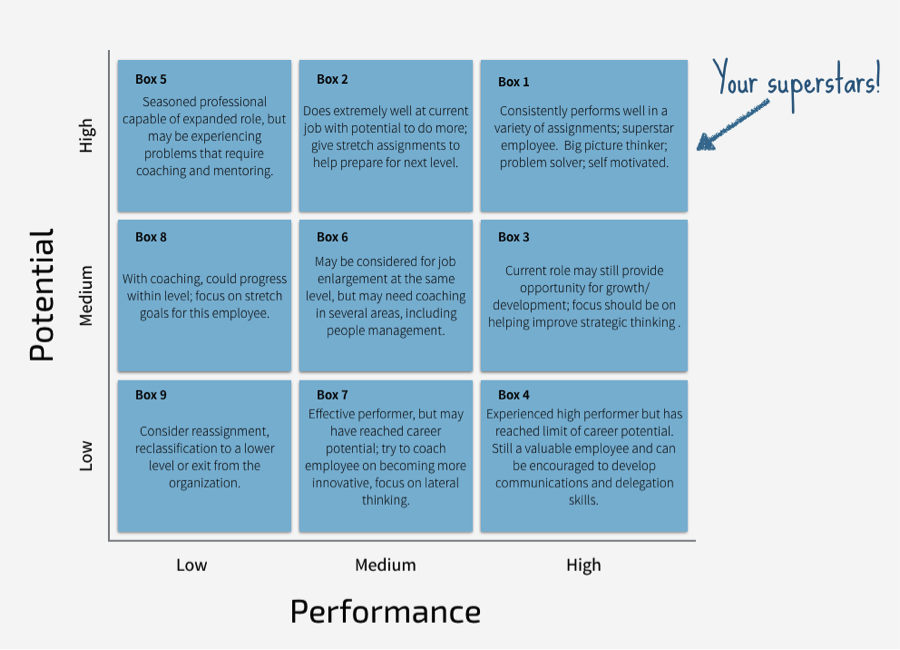Succession Planning with The 9-Box Grid on Performance Reviews
Posted by Hannah • November 5, 2015 (Last modified May 26, 2023) • 6 min read
Time has a funny way of continuing on whether we like it or not. One day your organization is operating at full speed, and the next a key member of your team shares the news they’re leaving. You can do everything in your power to keep engagement high and turnover low but people inevitably move on. What can you do? Succession planning!
By taking the time to plan for the future, you’ll successfully identify employees lower on the org chart who can be promoted when the time comes.
What is succession planning and why is it important?
Succession planning is the process of determining which employees can immediately take over a mid or senior-level position in the event it becomes available.
Succession planning prevents roles vital to your organization’s operations from being vacant for too long. You won’t have to go through a long hiring process and train a new team member on the nuances of your business.
Even more, succession planning provides the opportunity to take stock of your current workforce. You can discover who on your staff has the leadership qualities your organization values and start grooming them for a future promotion. You’ll also find other employees who could grow into a prospective manager with the right support and guidance.
Succession planning is mutually beneficial to your organization and employees. You won’t miss a beat when a valuable leader exits and you’ll boost employee engagement by providing career advancement opportunities to top performers.
Succession planning with the 9-box grid
The 9-box grid removes the guesswork in succession planning. It focuses on the two key aspects to consider before promoting an employee—performance in their current role and potential to take on increased responsibility and/or manage others.
Measuring performance is effortless if your organization defines role-specific goals across the workforce. You can generally group employees into three categories based on goals—high performers, medium performers, and low performers. High performers exceed goals, medium performers meet goals, and low performers fall short of most of their objectives.
Measuring potential is more complexed but can be accomplished by asking raters to consider the right factors. Using the Trakstar performance management solution, managers rate employees on a series of performance and potential-focused competencies using a 1-3 scale.
The results of every employees’ evaluation are displayed in a scatter plot across the 9-box grid. The horizontal x-axis represents an employee’s current performance (low performer, medium performer, and high performer). The vertical y-axis indicates their potential to be successful in a higher-level role.
The grid contains 9 distinct boxes logically arranged to inform your succession planning efforts. Employees who land in the upper right corner should be prioritized for promotion. Those who land in the middle need to improve their performance or potential before they’re ready for the next step in their career. And the team members who fall too close to either axis have a lot of work to do.
Let’s look at what each box represents and the action that can be taken to put every employee in a position to succeed.
Box 1 –The perfect combination of performance and potential. These superstars excel in their current role while also contributing ideas and actively thinking beyond their own objectives.
Action: Promote them when the right position opens.
Box 2 – Demonstrates leadership skills but hasn’t reached their full potential in their current role. With a little more effort, these team members can land in Box 1.
Action: Assign them challenging projects with tight deadlines and see if they step up.
Box 3 – Displays skills and work ethic but hasn’t fully developed into a leader. Box 3 team members are often young and require more work experience before they’re ready to manage others.
Action: Provide leadership training and mentorship and challenge them to contribute ideas.
Box 4 – A consistent top performer who exhibits little-to-no leadership qualities. These employees may have reserved personalities or no desire to step into another role.
Action: First ask about their career ambitions. If they want to climb the org chart, help them develop the soft skills they’re lacking (e.g. communication, confidence, etc.).
Box 5 – An experienced professional who is failing to meet expectations in their current role. Given that these employees are Box 1 candidates, their poor performance can be difficult to grasp.
Action: Find out why they’re unmotivated and provide coaching to improve performance or resolve any issues impacting their happiness. The goal is for them to shift into Box 1 or 2 during the next review period.
Box 6 – An adequate performer who displays okay leadership potential. Box 6 employees need to make strides in both areas before they can be considered for a promotion.
Action: Prioritize performance improvement while supporting their leadership development.
Box 7 – Meets most of their role-specific objectives but, unfortunately, doesn’t show management qualities.
Action: Similar to box 6, these employees first need to make a slightly better effort. It’s also worthwhile to discuss their personal goals and find out if they hope to advance their career with your organization.
Box 8 – An underperformer who may have some leadership abilities. However, their management potential is irrelevant until they make drastic improvements in their current role.
Action: Consider a Performance Improvement Plan (PIP) or other actions to help them meet their objectives.
Box 9 – The polar opposite of Box 1. These team members are failing in their current role and lack leadership potential.
Action: See Box 8 action.
Using the 9-box grid, you can zero-in on what matters in succession planning and find out who truly has what it takes to be a future leader. Instead of collecting anecdotal thoughts from managers, they rate all their direct reports on competencies proven to inform performance and potential. The result is a visual representation of hard data that shows who should be prioritized for movement up the org chart.
More succession planning tips
The 9-box grid is an excellent tool to use in succession planning. But what should you do after you’ve discovered your next generation of leaders? We’ll conclude with a few tips for taking your succession planning efforts to another level:
- Share the results with future leaders – You don’t have to tell the employee the exact position they’re penciled in to take over. But you can share the good news that they’ve been identified as a potential leader.
- Provide professional development training – Create courses for your employees that help them learn the necessary skills they’ll need to prepare for their next opportunity.
- Arrange job shadowing – Pair your superstars with senior employees so they get exposed to the day-to-day of leadership roles.
- Encourage mentorship – Ask your current leaders to provide guidance and advice to the younger employees on staff.
- Provide potential-focused feedback – Frequent performance feedback is always important. However, managers should also provide coaching that helps team members develop leadership skills.
- Gradually increase responsibility – Help a superstar get ready for the position that awaits them by assigning them some of the tasks they’ll eventually be responsible for.
Don’t get caught off guard when a manager or executive departs the organization. Participate in succession planning today using the 9-box grid so you’re prepared for whatever happens tomorrow.
Don't Miss Out on More Great HR Articles!
Subscribe to get the latest, greatest HR and Talent Development content straight to your inbox.




